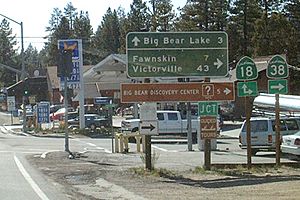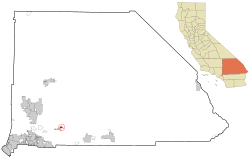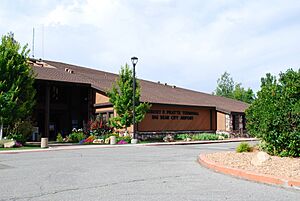Big Bear City, California facts for kids
Quick facts for kids
Big Bear City, California
|
|
|---|---|

Looking west at corner of Big Bear Boulevard and Greenway in Big Bear City. This is where Highways 18 and 38 cross over.
|
|

Location in San Bernardino County and the state of California
|
|
| Country | United States |
| State | California |
| County | San Bernardino |
| Area | |
| • CDP | 32.03 sq mi (82.96 km2) |
| • Land | 32.02 sq mi (82.92 km2) |
| • Water | 0.02 sq mi (0.04 km2) 0.05% |
| Elevation | 6,772 ft (2,064 m) |
| Population
(2020)
|
|
| • CDP | 12,738 |
| • Density | 397.88/sq mi (153.62/km2) |
| Time zone | UTC−8 (Pacific) |
| • Summer (DST) | UTC−7 (PDT) |
| ZIP Codes |
92314, 92386
|
| Area code | 909 |
| FIPS code | 06-06406 |
| GNIS feature IDs | 1660331, 2407838 |
Big Bear City is a special kind of town in San Bernardino County, California. It's not an official city, but it's a community located right next to Big Bear Lake. This area is surrounded by the beautiful San Bernardino National Forest.
Big Bear City is about 27 miles (43 km) northeast of the city of San Bernardino. It sits just east of the actual city of Big Bear Lake. The United States Census Bureau counts Big Bear City as a "census-designated place" (CDP). This means it's a place with a lot of people that the government tracks for statistics, even if it's not a city.
In 2020, about 12,738 people lived here. Big Bear City is mostly a place where people live, with many houses and cabins. It's also located along the famous Pacific Crest Trail, a long hiking path.
A long time ago, in 1929, an airline called Standard Air Lines started flying to Big Bear. The post office here was first named Van Duesen in 1927. But just six months later, it changed its name to Big Bear City. The Big Bear City Post Office has been open since 1928.
It's important not to confuse Big Bear City with the nearby city of Big Bear Lake. They are two different places!
Contents
Why is it Called Big Bear City?
Big Bear got its name because many grizzly bears used to live in the area. Sadly, grizzly bears are no longer found in the valley since the early 1900s. However, you can still find thousands of black bears roaming around Big Bear Valley today.
The Story of Big Bear City
Early People of Big Bear Valley
The very first people to live in Big Bear Valley were the Serrano Indians. Their name, Serrano, means "mountaineers" or "those of the Sierras." The Serrano people who lived in the San Bernardino Mountains called themselves Yuhaviatam, which means "people of the pines."
Experts believe the Serrano people first settled in Big Bear about 1,500 to 2,000 years ago. They had different homes for winter and summer. In winter, they lived in Lucerne Valley. But in summer, they moved to villages in the San Bernardino mountains. The higher altitude meant cooler weather.
Their villages were often near rivers and lakes. They also set up hunting camps higher up in the mountains. Besides hunting, they ate nuts, beans, berries, and seeds. One important Serrano site was in Big Bear City, called Kayah-pia-t. The Serrano groups from Big Bear and Lucerne Valley were part of the same tribe, called the Coyote Pervetum.
The Serrano people lived here because of the many natural resources. They gathered acorns and herbs. They also hunted deer, rabbits, and other animals. You can still see many "mortar holes" in Big Bear City. These holes were made by the Serranos to grind acorns into food.
The oldest known signs of human life in Big Bear Valley are at the Indian Grinding Rocks in Big Bear City. This place is called The Eye of God. It is a very special and sacred spot for the Serrano people. The Serrano creation story even happened at The Eye of God, which they called Hatauva.
The first time European settlers met the Serrano people in Big Bear was around 1774-1776. This happened when a Spanish priest named Father Francisco Garcés explored the area. Another record says the first meeting was in 1845. This was during a trip to deal with Native-Americans.
Where is Big Bear City?
Big Bear City is considered a "census-designated place" (CDP) by the U.S. Census Bureau. It covers an area of about 32 square miles (83 square kilometers). Almost all of this area is land, with only a tiny bit of water.
Nearby, you'll find popular ski resorts like Snow Summit and Bear Mountain.
Most of Big Bear City and its main shopping area are along Big Bear Boulevard. The western edge of the town is Division Road. The eastern edge is where Highway 38 turns off towards Redlands. Also, Highway 18 goes south to San Bernardino and north to Lucerne Valley.
The northern boundary is North Shore Road. The east-west postal line in Big Bear City is Green Way Drive. This is where Highway 18 (Big Bear Boulevard) turns north. It then crosses over to North Shore Drive, heading east towards Lucerne Valley. Highway 38, coming from the east, also turns north to North Shore. It then heads west to Big Bear Dam in the city of Big Bear Lake, California.
Sugarloaf is a large neighborhood located just south of Big Bear City.
Who Lives in Big Bear City?
Big Bear City has grown quite a bit over the years.
| Historical population | |||
|---|---|---|---|
| Census | Pop. | %± | |
| 1990 | 4,920 | — | |
| 2000 | 5,779 | 17.5% | |
| 2010 | 12,304 | 112.9% | |
| 2020 | 12,738 | 3.5% | |
| U.S. Decennial Census | |||
In 2010, there were 12,304 people living in Big Bear City. Most people lived in homes, with only a few in group housing. About 83% of the people were White, and about 19% were Hispanic or Latino.
Many families live here. About 31% of homes had children under 18. The average household had about 2.45 people. The average family had about 2.94 people. The median age of people in Big Bear City was about 43 years old.
Most homes were owned by the people living in them. About 68% of homes were owner-occupied, and 32% were rented.
Getting Around Big Bear City
The Big Bear City Airport is a "general aviation" airport. This means it's mostly for smaller, private planes. You won't find big commercial flights here anymore, though some airlines used to fly to Big Bear in the past.
The airport is also important for emergencies. It can be used for medical evacuations. It also serves as a base for planes that help fight forest fires nearby. Many local pilots who fly for fun enjoy using this airport.
Animals You Might See
Big Bear City is home to many different animals. You'll often see small mammals like squirrels, chipmunks, raccoons, coyotes, and skunks.
It's less common, but you might also spot black bears, mountain lions, bobcats, gray foxes, and mule deer.
Some animals, like mountain lions, black bears, and coyotes, can be dangerous. It's always good to be aware of your surroundings in nature.
As mentioned before, grizzly bears used to be common in Big Bear Valley. But they disappeared from the area by 1906.
Want to Learn More?
 In Spanish: Big Bear City para niños
In Spanish: Big Bear City para niños



